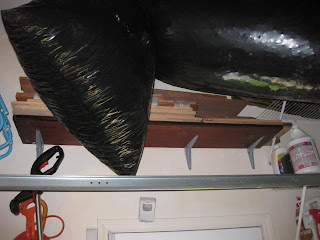Conventional wisdom would say that for serious hardwood furniture work one
must have a table saw, and not a $250 one either. Well let me tell you that there is an
alternative that:
- Needs very little space when not in use.
- Can be set up on a Black & Decker Workmate 425.
- Is much safer then any table saw.
- Collects saw dust better then any unit short of commercial $10,000 one.
- Is portable if needed!

The answer is a
Festool plunge saw system. I have an 8 year old model AFT 55 E. The current model is 55 EQ. The photo shows the plunge saw, a Workmate table set to just two top sections, a cutting surface (2 3/4" ply thick) which is leaning against a stack of Festool containers with the dust extractor at the bottom, it's hidden by the cutting surface.
The
safety of a plunge saw is that the blade drops down into the wood and is never exposed. The AFT 55 line uses a 6 1/4" diameter thin ferf blade yet achieves a cutting depth on the track system to handle 8/4 wood (1 15/16"). The blade's cutting width is 3/32". With the electronic controls the saw system will not damage itself. The speed light will glow red and the saw will stop. I've had this happen a few times when cutting 8/4 hardwoods.

The photo on the right shows my cutting arrangement and one end of a Festool Saw Guide Rail System. The top of the Workmate table is hidden. On it I've positioned the cutting board that was shown standing up in the first photo. This is bolted to the Workmate. On top of this surface is placed a sacrifice layer of 1/8" plywood. The layer is usually changed a few times a year. The Festool plunge saw has a 1 mm step positive stop depth feature. The best cut is obtained with just entering the sacrifice cover. At the end of the guide rail you can see one of the Festool end clamps used to secure the guide. These clamps slide into grooves in the rail. The setup shown has an oak 4/4 board set for a trim cut. The section to be cut off is to the left of the guide rail. I can cut off widths less then the blades kerf, 3/32", although one gets some dust. If I set the minimum width at say 5/32", there will be little dust not collected and one ends with a veneer strip.

The final photo shows the total system. The back of the saw is attached via a long green tube to the vacuum port of the dust extractor system. This unit has large caster wheels. Each Festool item comes in a plastic case which can mount on top of the dust extractor as shown in the photo. The tool being used, in this case the plunge saw is powered from the extractor. It senses when a tool is turned off and continues vacuum pressure for about 5 sec.
Setup and cutting is very easy with the Festool guide rails system. Once you have done a first cut against the rubber guide strip on the cutting side of the rail the position of all further cuts is shown by this edge. The cut width will be the blades 3/32" kerf. Thus a few marks will line up the cutting point.
For wood buildup this saw achieves clean enough cuts on hardwoods such that no sanding is necessary. It also keeps edge chipping to a minimum even on woods that a noted for some. For cut surfaces that will be exposed I usually only need light hand sanding to remove any saw marks.
The primary market, in my opinion, is for professional re-modellers that need to work in a client's home. Thus the focus on portability and dust extraction while giving the quality cut one would expect from a stationary table saw system costing $2,000 or more.
The net here my Festool Plunge Saw system is the single most critical component of me being able to do serious woodworking in a small space. If they could only come out with a lathe I could have every major wood tool in my small space.
[PS I have no stock or connection to the Festool corporation other then a very happy user of their products.]



















